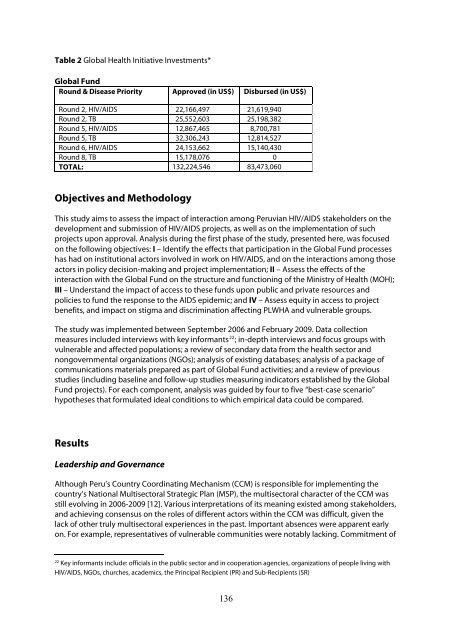MAXIMIZING POSITIVE SYNERGIES - World Health Organization
MAXIMIZING POSITIVE SYNERGIES - World Health Organization
MAXIMIZING POSITIVE SYNERGIES - World Health Organization
Create successful ePaper yourself
Turn your PDF publications into a flip-book with our unique Google optimized e-Paper software.
Table 2 Global <strong>Health</strong> Initiative Investments*<br />
Global Fund<br />
Round & Disease Priority Approved (in US$) Disbursed (in US$)<br />
Round 2, HIV/AIDS 22,166,497 21,619,940<br />
Round 2, TB 25,552,603 25,198,382<br />
Round 5, HIV/AIDS 12,867,465 8,700,781<br />
Round 5, TB 32,306,243 12,814,527<br />
Round 6, HIV/AIDS 24,153,662 15,140,430<br />
Round 8, TB 15,178,076 0<br />
TOTAL: 132,224,546 83,473,060<br />
Objectives and Methodology<br />
This study aims to assess the impact of interaction among Peruvian HIV/AIDS stakeholders on the<br />
development and submission of HIV/AIDS projects, as well as on the implementation of such<br />
projects upon approval. Analysis during the first phase of the study, presented here, was focused<br />
on the following objectives: I – Identify the effects that participation in the Global Fund processes<br />
has had on institutional actors involved in work on HIV/AIDS, and on the interactions among those<br />
actors in policy decision-making and project implementation; II – Assess the effects of the<br />
interaction with the Global Fund on the structure and functioning of the Ministry of <strong>Health</strong> (MOH);<br />
III – Understand the impact of access to these funds upon public and private resources and<br />
policies to fund the response to the AIDS epidemic; and IV – Assess equity in access to project<br />
benefits, and impact on stigma and discrimination affecting PLWHA and vulnerable groups.<br />
The study was implemented between September 2006 and February 2009. Data collection<br />
measures included interviews with key informants 22 ; in-depth interviews and focus groups with<br />
vulnerable and affected populations; a review of secondary data from the health sector and<br />
nongovernmental organizations (NGOs); analysis of existing databases; analysis of a package of<br />
communications materials prepared as part of Global Fund activities; and a review of previous<br />
studies (including baseline and follow-up studies measuring indicators established by the Global<br />
Fund projects). For each component, analysis was guided by four to five “best-case scenario”<br />
hypotheses that formulated ideal conditions to which empirical data could be compared.<br />
Results<br />
Leadership and Governance<br />
Although Peru’s Country Coordinating Mechanism (CCM) is responsible for implementing the<br />
country’s National Multisectoral Strategic Plan (MSP), the multisectoral character of the CCM was<br />
still evolving in 2006-2009 [12]. Various interpretations of its meaning existed among stakeholders,<br />
and achieving consensus on the roles of different actors within the CCM was difficult, given the<br />
lack of other truly multisectoral experiences in the past. Important absences were apparent early<br />
on. For example, representatives of vulnerable communities were notably lacking. Commitment of<br />
22 Key informants include: officials in the public sector and in cooperation agencies, organizations of people living with<br />
HIV/AIDS, NGOs, churches, academics, the Principal Recipient (PR) and Sub-Recipients (SR)<br />
136

















